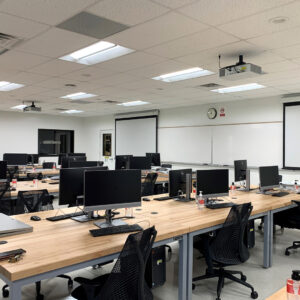Teaching Toward an Inclusive Architecture Industry
Yolanda Velazco, a top-notch designer at Platt/Whitelaw, is more than just an architecture instructor teaching at Southwestern College.
Having grown up in Mexico, and even having attended Southwestern College herself, Yolanda knows that navigating a college experience in a different country comes with a learning curve. Many of her students at Southwestern College grew up in Mexico.
Un-clashing cultures
“They’re coming from a different system, and there’s culture shock, too, even though we’re a border city,” said Yolanda. “Many know some English, but I can see how they struggle when they try to get into classes and things like that. I can help provide more than just an architectural education because I understand what they’re going through.”

She has provided this help through her stints teaching Studio 1, Studio 2 and Introduction to Architecture at Southwestern College in Chula Vista. This fall will mark her third semester of teaching.


“I’ve taught students of all ages and from very diverse backgrounds,” she said. “Some of my students are older than me. Some already finished their degree in architecture in Mexico. Regardless, I try to focus on how the system works as much as how to design.”
Yolanda says that she and some of her fellow teaching instructors have thought about creating a class focused on the differences between architecture in the U.S. and in Mexico, because those differences can be so stark.
Well-rounded education
Yolanda was surprised that the Introduction to Architecture class became her favorite to teach, even though the studio classes inspire her when her students push the boundaries of design and present new ideas.
“I share a lot of my experiences in the Introduction to Architecture class, and we talk about every aspect of what they may find themselves doing with an architecture education,” she said.
A lot of the course is driven by questions from the students themselves.
“I want them to feel more comfortable and informed about the decision they’re making,” she added. “I don’t want them to be scared, but I try to be realistic. I think about what I would have liked to know as a student.”
Fortunately, it’s a student body that’s not likely to scare easily.
“My students are super hard workers. Most are attending school while working full time,” said Yolanda.
Breaking barriers
While their drive is admirable, the students’ economic circumstances can be daunting when they think about supplementing the two-year associate degree they can earn at Southwestern College with a follow-on, baccalaureate degree.
“The closest public college they can attend to earn that full degree is California State University Pomona,” said Yolanda, who is a graduate of that program. “It’s difficult to get in, even as a transfer. You submit your portfolio, and based on that, they could send you down to first year, which would mean you’d still have to do five years of study.”
NewSchool of Architecture & Design is in San Diego, but it’s private and may be cost-prohibitive for some. If Southwestern students want to pursue a four- or five-year degree at either institution, they will need to pay rent if living away from family and will probably have less hours to work a job.
It’s this plight that has inspired Southwestern College to apply for the right to offer a baccalaureate degree (four- or five-year degree) in Architecture. Time will tell if the effort succeeds.
“We’ve been creating an elite major,” says Yolanda. She’s concerned that barriers exist to getting more minorities and people of color into architecture.
“Coming to Platt/Whitelaw made me feel comfortable because its leadership is diverse,” she said, but she added that it hadn’t been her impression of most architecture firms she had encountered.
Platt/Whitelaw Architects Principal Naveen Waney said, “Yolanda is a creative, motivated, strong-minded person. Once she gets something in her head, she will make sure she explores the subject to the fullest and returns with a responsive solution. That’s a trait you cannot teach and makes her a great teacher for budding architects.”
Words of advice
Yolanda also wants to make sure that architecture students master foundational skills.
“I feel with the technology and all tools available now, we’re losing the basics,” she said. “As a student, it’s hard to understand why hand drafting is important, but you always need to know the basics first to effectively use technology as a tool. I feel like I get picky about how graphics should look and plans should read, but those are your instructions to the person who’s going to build it.”
She added one last piece of advice for up-and-coming architects.
“You’re not supposed to know it all. Ask questions. There’s so much information out there.”





